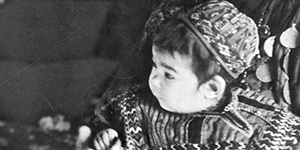
Pregnancy and birth, an auspicious time in Central Asia, is celebrated for forty days (an auspicious number in Islam) with great joy but also with trepidation, for fear that too much celebration will attract malevolent spirits. Due to a high infant mortality rate, families performed multiple rituals to maintain the health and well-being of mother and child. Tajiks did not permit a barren woman to visit a new mother unless she entered the room holding a piece of kurak (patchwork), which was thought to keep evil spirits at bay. Women maintained this belief even though it was not sanctioned by Islamic authorities. According to legend, forty days after the birth of her child—when the period of seclusion had ended—a Kyrgyz mother gathered pieces of cloth from forty neighboring yurts to make a talismanic shirt (kyrk koinok) for her child. Similarly, in parts of Tajikistan and Karakalpakstan, the mother followed the custom of collecting pieces of fabric “at seven doors” from families who were wealthy, had many healthy children, and where husband and wife had lived together until old age.
The festivity of beshik toi celebrates placing the baby in the cradle (beshik) for the first time, seven, nine, or eleven days after birth. Relatives of the mother purchase the richly decorated cradle constructed of mulberry and willow and deliver it to the son-in-law’s home with all accessories, toys, food, and gifts. Accompanied by musicians, the paternal grandfather takes the cradle on his right shoulder and transfers it to the right shoulder of his son, who then carries it to the mother. Samarkand Tajiks frequently used their patchwork wedding tablecloth (dastarkhan) as a cradle cover (gavarah posh—Tajik; beshik push—Uzbek) for their first child, which provided protection long after the ritual. Women sewed variously colored kurak covers and mattresses for infants. A two-part quilted cover made specifically to fit over the cradle, shielded the child from dust and light.